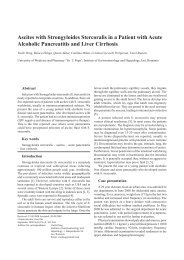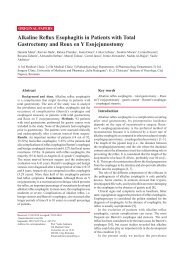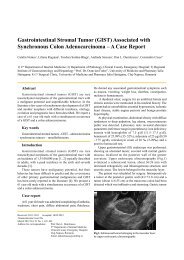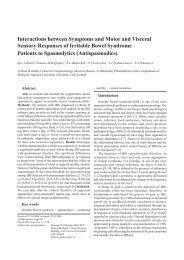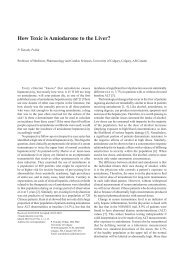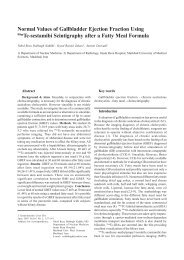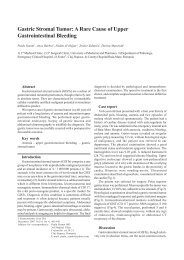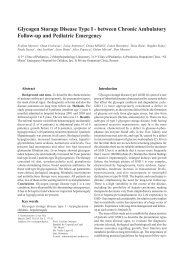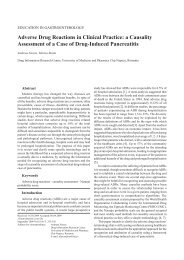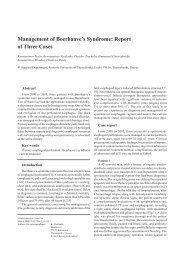The Association Between Helicobacter Pylori Chronic Gastritis ...
The Association Between Helicobacter Pylori Chronic Gastritis ...
The Association Between Helicobacter Pylori Chronic Gastritis ...
Create successful ePaper yourself
Turn your PDF publications into a flip-book with our unique Google optimized e-Paper software.
312 Andreica-Sandica et al<br />
extraction wounds. She presented moderate abdominal pain<br />
at palpation, and a visible xypho-umbilical scar, secondary to<br />
the exploratory laparotomies, and a post-appendectomy scar<br />
in the right iliac fossa. <strong>The</strong> stool had the aspect of melena.<br />
<strong>The</strong> psychiatric and psychological examination revealed:<br />
deficient amnesia on three episodes (when she goes to the<br />
place where the rape happened, she “awakens”, doesn’t know<br />
who she is, checks her ID card for her name and address),<br />
irritability, emotional weakness, diminished self-defense<br />
instinct; she blocked herself when attempting to discuss<br />
the trauma suffered, spoke of her daughter as if she were<br />
her sister, has a craving for attention, need to impress her<br />
entourage, normal intellectual ability, developing personality<br />
with unstable psycho-affective elements, state of depression<br />
and diminished tolerance to stress, sleep complaints,<br />
impulsive and aggressive tendency.<br />
<strong>The</strong> neurological examination showed unsystematic<br />
hypoesthesia in the right upper limb.<br />
Laboratory investigations were normal, except mild<br />
anemia: erythrocyte count 4.38 mil/μl (VN=4.3-5.4),<br />
hemoglobin 10.8 g/dl (VN=12.1-17.2); hematocrit 34.4%<br />
(36.8-50.2), mean erythrocyte volume 78.4 fl (VN=83-93),<br />
mean erythrocyte hemoglobin 24.7pg (VN=26.8-31.8).<br />
At the upper digestive endoscopy repeated on admission,<br />
oesophagus, gastric body, duodenum evidenced a normal<br />
endoscopic aspect. <strong>The</strong> histopathological examination<br />
showed a superficial chronic gastritis, with a moderate<br />
inflammatory infiltration with round-nuclear and rare PMN<br />
cells in the chorion, and presence of HP.<br />
<strong>The</strong> oto-rhino-pharyngeal examination evidenced a<br />
normal aspect. <strong>The</strong> EEG in the awake state presented<br />
hypovolted trajectory, insufficiently developed, slower<br />
in right centro-parietal derivations (lesional?). A cerebral<br />
angio MRI scan was then recommended. This revealed a<br />
millimetric lesion most probably of an inflammatory nature<br />
located at the left external capsule level; without any further<br />
focal cerebral lesions; without super or infratentorial tumor<br />
formations; non-dilated symmetrical ventricular system. A<br />
repeat scan at 6 months was recommended.<br />
We established the diagnosis of superficial chronic<br />
gastritis with HP infection, melena following ingestion<br />
of blood resulting from the dental auto extraction wound,<br />
mild anemia, somatization disease and post-traumatic stress<br />
syndrome.<br />
Discussion<br />
Rape represented the ”trigger” factor which coincided<br />
with the onset of a series of painful recurrent digestive<br />
syndromes, the patient being diagnosed with chronic gastritis,<br />
a renal cyst, appendicitis. For certain digestive complaints,<br />
even surgical interventions were performed. <strong>The</strong> patient<br />
simultaneously developed a complex psychiatric picture:<br />
acute reaction to stress, post-traumatic stress disorder,<br />
dissociative psychosis, post psychotic depression.<br />
As a reaction to trauma the patient developed a separate<br />
personality from which she could not access information<br />
related to the rape, and another one (to the forefront during<br />
anamnestic incursions or during hypnosis) in which she relived<br />
the traumatic event. <strong>The</strong> feelings blocked by the impossibility<br />
of verbalization found an outlet through the body, in the form<br />
of pain with different locations (predominantly digestive<br />
tract), paresthesia alternating with painful anaesthesia (she<br />
manually extracted two of her molars, while hematemesis<br />
and melena proved to be the result of inducing haemorhage<br />
in the dental insertion slots).<br />
<strong>The</strong> complaints reported by the patient exceeded the<br />
usual complaints of gastritis. <strong>The</strong> patient presented a history<br />
of multiple somatic complains, occurring over two years<br />
(epigastric pain, pain in the lower abdomen, precardial and<br />
back pain, hematemesis, melena), which could not be fully<br />
justifiable by a commonly accepted medical condition [2].<br />
Numerous studies have tried to verify the hypothesis<br />
that trauma can trigger gastric pathology; however,<br />
data is conflicting [3-5]. <strong>Gastritis</strong> and peptic ulcer were<br />
initially described as psychosomatic pathology, having as<br />
vulnerability factors an ambitious or dependent personality.<br />
But because no strong association was discovered between<br />
the psychogenetic factors and the digestive symptoms or the<br />
endoscopic aspect of the stomach, research was gradually<br />
oriented towards the discovery of other etiologies [6, 7].<br />
Over the past decades, in the pathogenesis of ulcer<br />
and gastritis the role of HP infection and of non steroid<br />
anti-inflammatory drugs (NSAIDs) has been documented.<br />
Epidemiological studies have shown that despite the decrease<br />
in the HP prevalence in Western countries and the increase<br />
in the availability of anti-HP drug therapy, the prevalence of<br />
peptic diseases is relatively high [8]. A proportion of those<br />
infected with HP do not develop gastric pathology [6]. In<br />
5-20% of the patients with gastric disease no etiologic factors<br />
are identified [9, 10].<br />
Some studies evaluated the association between early<br />
trauma, anxiety and gastric ulcer/gastritis [11]. <strong>The</strong>re are<br />
several explanations for this association. Starting from the<br />
onset at an early age of generalized anxiety, the idea was<br />
postulated that chronic anxiety could in time determine<br />
dyspeptic symptoms, as well as peptic diseases [11].<br />
<strong>The</strong> hypothesis of a common genetic predisposition for<br />
anxiety and ulcer was issued [12]. Proof also exists that<br />
the recurrence of gastritis/ulcer can be associated with the<br />
presence of stressful life events [13]. An association between<br />
acute stress (earthquake, for example) and heightening of<br />
induced gastric lesions with HP was also identified [14].<br />
Based on the data presented by the patient, we do not<br />
consider that her clinical picture was the expression of<br />
chronic HP positive gastritis. <strong>The</strong> exacerbation of abdominal<br />
pains took place in the psychological context of the patient.<br />
Self mutilation (tooth extraction) expresses the patient’s<br />
intention (through bleeding) to make the digestive pains<br />
more plausible. <strong>The</strong> confirmation that she suffers from a<br />
severe digestive disease would enable her to substitute the<br />
tribulations generated by the gastric pain.<br />
A prospective study carried out on 2,416 patients not<br />
diagnosed with an ulcer showed that the use of minor




